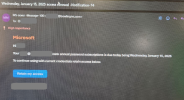britechguy
Well-Known Member
- Reaction score
- 4,747
- Location
- Staunton, VA
This one has practically every red flag that it could have, but I am thrilled that my client texted me with a screenshot asking my opinion before even considering taking action . . .

Red Flags including:
misspelling "sever" for "server"
non-microsoft domain originating email address
no Microsoft logo
"annual password subscriptions" (WTF, that's one I've never seen before and is just so blatantly stupid!)
The directive to get you to click on the "Retain my access" button is not even close to standard English.
My Reply:
. . . it absolutely is NOT legitimate. Microsoft never, ever, ever sends out anything that does not have "@microsoft.com" in the sender's email address. I'd delete it and get on with life. This having been said, even if it looked 100% legitimate, you never log in using a link or button contained in an email message. If the message is legitimate, then logging in to your Microsoft account directly from the Microsoft website will show the same message in your private messages box. If you log in and don't find that same message there, you absolutely know it's a fake. This is why one never, ever, activates links/buttons in any email message where an account login appears to be involved. You always open your web browser and go to that account's site BY HAND and then log in to the account. That always protects you from scams.

Red Flags including:
misspelling "sever" for "server"
non-microsoft domain originating email address
no Microsoft logo
"annual password subscriptions" (WTF, that's one I've never seen before and is just so blatantly stupid!)
The directive to get you to click on the "Retain my access" button is not even close to standard English.
My Reply:
. . . it absolutely is NOT legitimate. Microsoft never, ever, ever sends out anything that does not have "@microsoft.com" in the sender's email address. I'd delete it and get on with life. This having been said, even if it looked 100% legitimate, you never log in using a link or button contained in an email message. If the message is legitimate, then logging in to your Microsoft account directly from the Microsoft website will show the same message in your private messages box. If you log in and don't find that same message there, you absolutely know it's a fake. This is why one never, ever, activates links/buttons in any email message where an account login appears to be involved. You always open your web browser and go to that account's site BY HAND and then log in to the account. That always protects you from scams.
